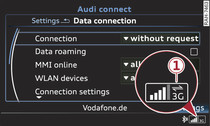|
-

- Fig. 1 Menus and symbols
-

- Fig. 2 Configuring data connection
(A)
(B) Symbol / marking
(C) Explanation
(B) Symbol / marking
(C) Explanation
| (A) |
(B) |
(C) |
|---|---|---|
| -1- |
Selected option |
Selected function |
| -2- |
Arrow for
up/down |
Further available functions |
| -3- |
Mute |
Audio source muted
►Link |
| -4- |
TMC |
Reception of TMC traffic information
►Link |
| -5- |
Copying procedure |
Copying audio/video files to the jukebox
►Link |
| -6- |
Time |
Time setting
►Link |
| -7- |
Telephone |
Missed calls
►Link |
| -8- |
Envelope |
Unread text message (SMS)
Crossed-out envelope: text message memory is full |
| -9- |
Signal strength bars for mobile phone* |
Reception strength of mobile phone network of a connected mobile phone
►Link |
| -10- |
Signal strength bars for data connection* |
Reception strength of the active connection, or
PIN: Enter the SIM PIN code PUK: Enter the PUK code SIM: Insert the SIM card ►Link |
| -11- |
TP |
Reception of traffic announcements
►Link |
| -12- |
Update procedure |
Update of the navigation database
►Link |
| -13- |
Import procedure |
Import/update of contacts in the directory/call list |
| -14- |
Bluetooth* |
Bluetooth device connected
►Link /
►Link |
| -15- |
2G/3G/LTE* |
Network coverage of the active connection
►Link
2G: GSM network 3G: UMTS network LTE: LTE network When a data connection has been established, a symbol indicating the active data connection -1- Fig. 2 appears in the status line of the MMI display |
| -16- |
Entry field |
Entries that can be changed using the speller for letters/numbers
►Link |
| -17- |
Selection list |
Settings for the selected function that can be called up by pressing the rotary pushbutton |
| -18- |
Arrow |
Submenu with additional functions that can be called up by pressing the rotary pushbutton |
| -19- |
Heading |
Selected menu (e.g.
Telephone) |
